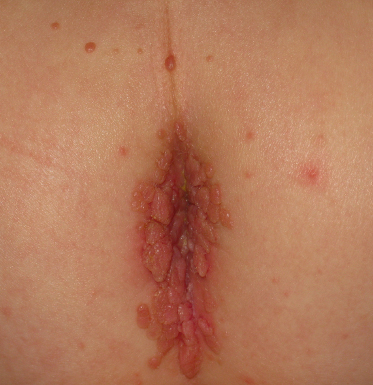In addition, there are some acute genital injuries that are concerning, although not diagnostic of sexual abuse, such as bruising or lacerations of the vulva, penis, scrotum, perineum or perianal area. These injuries can be caused by accidental mechanisms, but should be accompanied by a clear and plausible description of the event leading to the injuries. Other findings, such as deep notches in the posterior hymen or apparent scarring of the posterior fourchette or anus can be suggestive of previous trauma, but may also represent normal variants in genital and anal anatomy [3].
Sexually Transmitted Infections
Children with genital lesions may be referred for evaluation by a dermatologist for biopsy and/or resection. Therefore, it is important to know the genital lesions that result from sexually transmitted infections (STIs).
Human Papillomaviruses
Human papillomavirus (HPV) infection can produce genital warts, which are benign epithelial proliferations. Anogenital infection produces large skin-coloured lesions known as condyloma accuminatum (Fig. 155.2).
HPV infection is the most common STI in the USA. In adults, anogenital HPV is primarily sexually transmitted; in children, anogenital HPV is a concerning finding, but emerging evidence suggests that sexual transmission is not the only route of transmission in small children. HPV can be transmitted in the perinatal period; because many adults with HPV infection are asymptomatic and most infections are transient, a child’s mother may not provide a history of genital warts or abnormal Papanicolaou (PAP) smears. In children who require toileting assistance or napkin changes, inoculation of the anogenital area with HPV may occur innocently because of poor hand hygiene [6]. They may also occur from self-inoculation.
The evaluation of a child with anogenital condyloma accuminatum should include genital examination and testing for other STIs; specific genital injuries or coinfection with another STI is highly suggestive of sexual abuse. However, as the transmission of HPV may be innocent and the incubation period for HPV may be as long as several years, presence of HPV infection itself is not diagnostic of sexual abuse [7].
Herpes Simplex Viruses
Genital herpes infection appears as a vesicular eruption that progresses to ulcerative lesions. These lesions are painful, and pain often begins before lesions can be seen. After primary infection, herpes simplex virus (HSV) remains latent in sensory nerve ganglia, and may recur through the patient’s lifetime. HSV infection is transmitted through direct contact with infected secretions, either oral or genital, and the incubation period is between 2 days and 2 weeks. While HSV-1 and HSV-2 have been classically associated with oral and genital infections, respectively, there is significant cross-over, and in some regions HSV type is no longer strongly associated with site of infection [8].
In children, genital HSV infection can be caused by autoinoculation from oral herpes lesions. However, as with HPV infection, children with genital HSV infection should undergo genital examination and testing for other STIs. Genital HSV-2 infection in children is highly concerning for sexual abuse, and should be reported to child protective services. Varicella zoster virus can also occur in the anogenital area, and has been mistaken for sexual abuse [9].
Syphilis
Primary syphilis lesions present as painless indurated ulcers at the site of primary inoculation. Chancres typically appear about 3 weeks after exposure, and resolve spontaneously within a few weeks.
Secondary syphilis can produce a maculopapular rash, as well as condyloma lata, hypertrophic papules occurring around the vulva or anus. These dermatological findings may be associated with lymphadenopathy, fever, malaise and other constitutional symptoms. However, the presentation of secondary syphilis is highly variable, and the absence of other non-dermatological symptoms does not rule out the possibility of syphilis [10].
As these dermatological manifestations of syphilis are specific to transmission outside the neonatal period, any child presenting with these forms of syphilis should be reported to child protective services, even without disclosure of sexual abuse by the child [11].
Lymphogranuloma Venereum
Chlamydia trachomatis can cause an invasive lymphatic infection, lymphogranuloma venereum, which presents initially as a painless genital ulcer and unilateral painful lymphadenopathy [12]. This presentation is uncommon in children, but has been reported.
Asymptomatic C. trachomatis infection of the vagina and rectum can be acquired at birth, and can remain latent until up to 3 years of age. Regardless of this, children with anogenital chlamydial infections should be evaluated for sexual abuse, including screening for other STIs [13].
Chancroid
Haemophilus ducreyi infection presents initially with an erythematous tender papule that progresses to a necrotic ulcerated lesion, often associated with unilateral inguinal lymphadenitis. Untreated, this lesion can resolve spontaneously. The rate of co-infection with other STIs is significant, as this infection is also highly associated with prostitution and use of illicit drugs. There is no known route of non-sexual transmission for H. ducreyi [14].
Differential Diagnosis of Child Sexual Abuse
Stay updated, free articles. Join our Telegram channel

Full access? Get Clinical Tree









